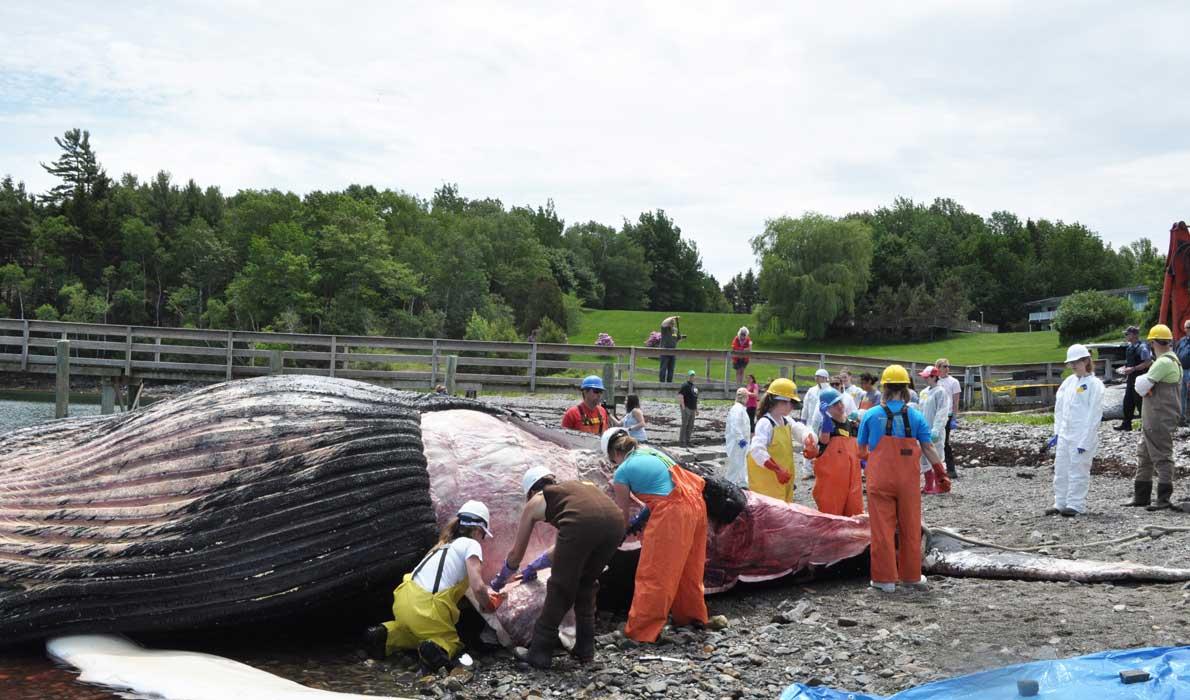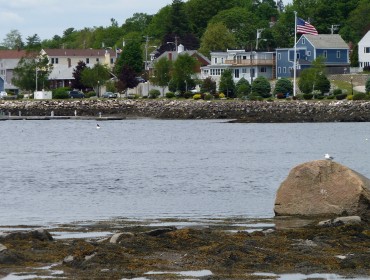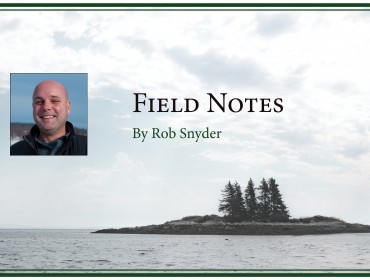Posted July 16, 2015
Last modified July 16, 2015
By Laurie Schreiber
In early June, a 35-foot female humpback whale washed up dead on Mount Desert Island. The 11-year-old whale, known as Spinnaker to the whale research and disentanglement network on the East Coast, had been involved in three known entanglements in gillnet and lobster trap gear. Researchers believe it suffered infection from at least one of the entanglements.
The fishing industry becomes apprehensive after such deaths, because the federal rules formulated to protect whales from fishing gear were the result of a hard-won series of compromises. Those compromises could unravel, fishermen fear, and far more onerous rules could follow if evidence suggesting more conflict between the industry and the mammals mounts.
Another wrinkle in that delicate balance is that the feds have proposed removing humpbacks from the endangered species list.
Spinnaker was disentangled in 2006 by the Provincetown, Mass.-based Center for Coastal Studies (CCS) and its partners. In September 2014, Spinnaker was found entangled off Mount Desert Rock, with gillnet lodged in its mouth and around its head, and rope from lobster trap gear wound tightly approximately 30 times around its tail—all heavy enough to anchor the whale in place. Rescue teams freed it.
In May, Spinnaker was freed from another entanglement in the Gulf of Maine, a life-threatening situation in which it was tied by heavy gear from mouth to tail.
A month later, in keeping with the North Atlantic humpback’s typical migration patterns, Spinnaker was still in the gulf, likely visiting traditional summertime feeding spots. On June 11, it was found dead, floating below a shoreside cliff in Acadia National Park.
The humpback population generally is found 15-50 miles offshore. Like other North Atlantic humpbacks, Spinnaker's movements were tracked through photo-ID catalogues curated by CCS and Allied Whale, the marine mammal research group of Bar Harbor-based College of the Atlantic. As an organization authorized by the federal government to respond to marine mammal emergencies, Allied Whale traveled to the scene, towed it to a beach, and performed a necropsy that found rope embedded in the soft tissue and bone of the roof of its mouth, with associated necrotic tissue and loose bone fragments.
The type of floats on the rope identified it as gillnet gear, likely coming from beyond state waters. There also was evidence of infection in the throat and muscles close to the larynx.
Three days earlier, a female sei whale, with marks consistent with entanglement but no gear on it, washed up further east on Great Wass Island. On average, Allied Whale sees one dead whale per year, but sometimes two or three.
WHALE DEATHS
According to the National Marine Fisheries Service, from 1997 through 2010, entanglements killed 20 humpbacks, 31 minke whales, eight right whales and six finbacks. In the same period, 35 humpbacks sustained serious-injury entanglements.
Approximately 12,000 humpbacks live in the North Atlantic. Of the 1,000 or so that feed in the Gulf of Maine, more than half exhibit scarring likely resulting from entanglement, according to CCS. Scar acquisition rates indicate that an average of 12 percent of the population becomes entangled annually. In the past few years, CCS received on average 20 disentanglement cases per year, for all species along the Eastern Seaboard, said Scott Landry, director of the Marine Animal Entanglement Response team at CCS.
“People will say that’s a small number, and we say yes, but it’s not the actual number,” Landry said. “What we tend to count are the things we see, the whale that happens to cross our path and we see it’s entangled. There’s a lot of evidence that there are a lot of whales swimming around with gear on them right now. The ocean is big, and they move around a lot."
Since 1997, the federal government has enacted an evolving suite of measures to address the problem (measures also are in place to mitigate ship strikes). Distinctive gear marks are prescribed based on areas fished, aimed at identifying where entanglements originated. Fishermen keep their lines as knotless as possible, and use surface-system “weak links,” both intended to make it easier for a whale to disentangle itself. More recent efforts reduce lines in the water. Floating groundlines—those that tether lobster traps together—were replaced by lines with negative buoyancy that lie on the seabed.
This year, a new measure decreases the number of vertical lines—those extending from surface to trap—by requiring a minimum number of traps per line, depending on location. Regulations in Massachusetts also restrict fixed-gear from critical areas or times of year.
EXEMPT, FOR NOW
Much of the nearshore Maine coast is exempted from the line rules. The exemption is based on studies that show a low incidence of endangered whales in state waters. But many Maine fishermen fish at least part of the time outside the exempted area.
Maine’s lobster industry has been closely involved in the plan’s development from the start. Among current initiatives is a computer-modeling project to simulate whale/gear interaction, aimed at stimulating new ideas for mitigating the problem.
“It’s been a real evolution for us to figure out what the lobster industry can do to help the whales,” said Maine Lobstermen’s Association (MLA) executive director Patrice McCarron. “We need better information. Because we don’t observe whales becoming entangled, it’s difficult to figure out what happened and how we might change. We want to minimize serious injuries and mortality. But unless we take all fishing gear out of the water, humans and whales will always share the ocean. The job of the fishing industry is to make sure we reduce the likelihood of an interaction harming a whale.”
Bass Harbor lobsterman Jim Dow, who serves on the MLA board, agrees.
“There isn’t a fisherman out there who wants to see a whale get entangled, especially to the point where it dies,” he said. There’s an irony in the situation. Whale conservation efforts have had some success for some species. The North Atlantic humpback population, for example, has increased six-fold since the 1970s. “But the more the whale population increases, the more interaction we’re going to see, and I’m not sure what more can be done about that,” Dow said.
Federal fishery managers have set a five-year period to study the effectiveness of the line rules and say no further measures are expected within that window. But McCarron said the industry is keeping an eye on a proposed federal measure to designate the entire Gulf of Maine as critical foraging habitat for the highly endangered right whale. The proposal says commercial fishing won’t be affected. Still, said McCarron, “We want to make sure people don’t take advantage of the critical habitat designation to put more regulations on the fishing industry.”
A variety of groups are looking at the effectiveness of the gear modifications, including CCS. Preliminary information indicates the rules haven’t much abated the entanglement problem, said Landry.
“It’s not because people aren’t trying,” he said. “The fishing community has made sacrifices. But it’s hard to find a compromise between what works for whales and what works for the industry.”
Contributed by




